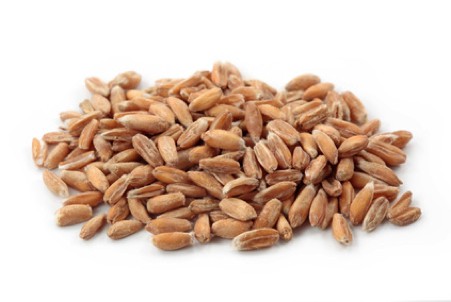By Nadia Marshall
What is Spelt?
Spelt (Triticum spelta) is a very old grain related to common bread wheat (Triticum aestivum). It was widely cultivated by ancient civilisations in Europe and the Middle East but fell out of favour in the 19th century as modern farming techniques began to develop. Spelt has a very hard outer husk that required two mechanistic processes for it to be removed. Bread wheat, on the other hand, had a husk that could be removed in a single process so it became the crop of choice. Spelt was re-discovered relatively recently in Europe, in the 1980s. New machinery has been developed to facilitate its harvesting in commercial quantities and it is now experiencing a major resurgence in many parts of the world due to its environmental and health benefits.
What are its qualities?
From an Ayurvedic perspective, spelt has the following qualities...
Rasa: Pungent, Astringent
Virya: Heating
Vipaka: Pungent
Qualities: Light, Dry
Actions on the doshas: Balances Pitta and Kapha, increases Vata in excess
Action on the mind: Sattvic
What are its medicinal qualities?
From an Ayurvedic perspective, spelt flour is Pungent, Astringent, Heating, Light and Dry. In contrast, wheat flour is Sweet, Cooling, Heavy and Oily. So from an Ayurvedic perspective it is easy to see why Spelt is so much easier to digest – its qualities are more consistent with the qualities of our digestive fire while wheat has opposing qualities. When you combine spelt with a grain like buckwheat, you create a more Tridoshic mix (balancing to all constitutions).
Spelt is a very nutritious grain but, unlike wheat, is also light and relatively easy to digest. Many people who are intolerant to wheat find they can eat spelt without a problem. This is perhaps because it contains far less gluten, has undergone less genetic modification, the gluten in spelt is more soluble and the proteins in spelt are more water soluble making it generally easier to digest.
The Western viewpoint.
According to the nutritional info on my biodynamic bag of spelt flour, it is approximately 70% carbohydrate, 13% protein and 3% fat. It contains high quantities of Manganese and moderate amounts of B Vitamins, Phosphorus, Copper, Magnesium, Iron and Zinc. It is also high in insoluble fibre. Spelt has a low GI of just 45 due to its fibre and protein content (wheat is more like the 50-70 mark) and is mildly alkaline (due to its high quantities of the alkaline minerals magnesium, manganese and iron).
Environmental benefits
Spelt is a low yield crop so grows well in relatively poor quality soils, doesn’t deplete soils as much as modern crops or require the application of fertilisers. Its hard outer husk protects it from frost, insects and pollutants and helps it to store well for longer periods of time. Because it hasn’t undergone genetic modification, it is resistant to diseases that often plague modern crops and grows successfully without the application of pesticides, fungicides or herbicides.
How do you eat it?
Spelt flour tastes quite different to wheat and behaves differently when cooked, due to its greater solubility in water (which means you need to use less water when substituting it with wheat flour) and lower gluten content (which means you need to knead it less than when making bread with wheat). It has a delicious nutty flavour and is also a little darker than wheat. I’ve mainly used it for making pancakes and cookies and it is perfect for both of these. But I usually combine it with a little buckwheat (usually 2/3 spelt, 1/3 buckwheat) to help balance its light, dry qualities...
Why do I love it?
I love how light spelt feels in my belly compared to wheat, I love its deep colour and distinctive nutty taste. l also really like its story... that it went from being the most consumed crop in Europe to virtually disappearing and now it is making a comeback! It is an ‘underdog’ crop... and everyone loves an underdog! In many ways its tough outer shell has protected it from more than just frosts and insects.... it protected it from scientific modification... so it has been preserved in its ancient state. That is pretty cool!
Should anyone avoid eating it?
Because it still contains gluten, people with celiacs disease should avoid eating spelt. People with pure Vata constitutions or severe Vata imbalances shouldn’t eat huge amounts of spelt unless they are combining it with buckwheat, making it a more balanced flour.
Where do you get it from?
You can buy Organic Wholemeal Spelt Flour from most whole-food or healthfood stores. You can even buy it from Woolies! If you live around Northern NSW you can it from Santos and also The Source in Mullum.
Finally, below are a couple of videos showing ways to use spelt flour... as Ayurvedic Ginger Cookies or chappattis!
Enjoy xxx
Love
Nadia x
References:
http://www.biodistributors.com.au/ProdInfFiles/spelt.php
http://www.whfoods.com/genpage.php?tname=nutrientprofile&dbid=144
http://www.nutritionrank.com/calories-spelt-9377
http://www.edensoriginal.com/en/glycemicindex
http://www.alkalizingdiva.com/acid-alkaline-food-chart/

Spelt: The Ayurvedic Perspective
AYURVEDIC TERMINOLOGY
Agni - the digestive fire.
Ama or Aama - undigested food waste, toxins.
Ojas- the foundation of our immune system and longevity.
Dhatus - the tissues of the body.
Srotas - the channels of the body.
Vata - the air/ether
intelligence in the body.
Pitta- the fire/water
intelligence in the body.
Kapha- the water/earth intelligence in the body.
Sattva- the quality of purity, intelligence, peace and love.
Rajas- the quality of
turbulence and activity.
Tamas- the quality of
dullness, darkness and inertia.
Rasa - the taste of a food (Sweet, Sour, Salty, Pungent, Bitter, Astringent)
Virya - second level of digestion (either Heating or Cooling)
Vipaka - third level of digestion, the deep taste of a food (can be Sweet, Sour or Pungent)
Prabhav - the 'special effect' of a food or herb/spice
Rasa - also the name for plasma tissue
Rakta - blood tissue
Mamsa - muscle tissue
Meda - fat tissue
Asthi - bone tissue
Majja - nerve & bone marrow tissue
Shukra - sexual reproductive tissue


